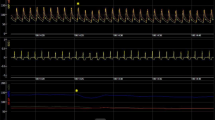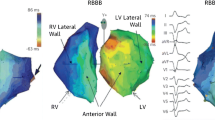Abstract
Introduction
Cardiac resynchronization therapy (CRT) is a well-established therapy for patients with moderate-to-severe heart failure (HF), left ventricular dysfunction with an ejection fraction ≤ 35% and a QRS on the surface electrocardiogram of ≥130 msec. Device optimization is often performed, adjusting the timing of RV and LV stimulation to produce a pacing sequence that yields the best global cardiac performance. However, no standard guidelines exist for optimization and many invasive and non-invasive techniques have been employed with mixed results. The aim of the present study was to determine whether there are any clinical predictors of the optimal V-V settings in patients implanted with CRT devices.
Methods and results
We prospectively evaluated 47 consecutive patients with HF who were referred to our device optimization clinic. The mean patient age was 64.9 ± 12.7 years. Patients were in both sinus rhythm (83%) and atrial fibrillation. Prior to device implant, 51% of patients had left bundle branch block (LBBB), 17% had intra-ventricular conduction delay (IVCD) and 21% were RV paced. Sixty-two percent were male, the mean QRS duration was 152 ± 29 ms, mean LVEF 26 ± 8% and 60% had a non-ischemic cardiomyopathy. Overall, 82% of patients required sequential pacing with 69% requiring LV pre-excitation to produce the best global cardiac function as determined by aortic velocity time integrals (VTI). In our cohort, none of the clinical characteristics evaluated, including etiology of the cardiomyopathy, QRS duration, LVEF, pre-implant rhythm or AV delay were predictive of an optimal simultaneous or sequential V-V setting.
Conclusions
None of the clinical variables tested in our analysis predicted optimal RV-LV settings. Our results suggest that individual optimization and programming of V-V settings is necessary. The inability to predict optimal settings likely reflects the unique characteristics of each patient and supports the need for individualized programming of each device.



Similar content being viewed by others
References
Abraham, W. T., Fisher, W. G., Smith, A. L., et al. (2002). Cardiac resynchronization in chronic heart failure. The New England Journal of Medicine, 346, 1845–1853.
Cazeau, S., Leclercq, C., Lavergne, T., et al. (2001). Effects of multisite biventricular pacing in patients with heart failure and intraventricular conduction delay. The New England Journal of Medicine, 344, 873–880.
Cleland, J. G., Daubert, J. C., Erdmann, E., et al. (2005). The effect of cardiac resynchronization on morbidity and mortality in heart failure. The New England Journal of Medicine, 352, 1539–1549.
Bristow, M. R., Saxon, L. A., Boehmer, J., et al. (2004). Cardiac-resynchronization therapy with or without an implantable defibrillator in advanced chronic heart failure. The New England Journal of Medicine, 350, 2140–2150.
Reuter, S., Garrigue, S., Barold, S. S., et al. (2002). Comparison of characteristics in responders versus nonresponders with biventricular pacing for drug-resistant congestive heart failure. The American Journal of Cardiology, 89, 346–350.
Richardson, M., Freemantle, N., Calvert, M. J., Cleland, J. G., & Tavazzi, L. (2007). Predictors and treatment response with cardiac resynchronization therapy in patients with heart failure characterized by dyssynchrony: a pre-defined analysis from the CARE-HF trial. European Heart Journal, 28, 1827–1834.
Bax, J. J., Van der Wall, E. E., & Schalij, M. J. (2002). Cardiac resynchronization therapy for heart failure. The New England Journal of Medicine, 347, 1803–1804 author reply 1803–4.
Bordachar, P., Lafitte, S., Reuter, S., et al. (2004). Echocardiographic parameters of ventricular dyssynchrony validation in patients with heart failure using sequential biventricular pacing. Journal of the American College of Cardiology, 44, 2157–2165.
Leon, A. R., Abraham, W. T., Brozena, S., et al. (2005). Cardiac resynchronization with sequential biventricular pacing for the treatment of moderate-to-severe heart failure. Journal of the American College of Cardiology, 46, 2298–2304.
Sogaard, P., Egeblad, H., Pedersen, A. K., et al. (2002). Sequential versus simultaneous biventricular resynchronization for severe heart failure: evaluation by tissue Doppler imaging. Circulation, 106, 2078–2084.
Rao, R. K., Kumar, U. N., Schafer, J., Viloria, E., De Lurgio, D., & Foster, E. (2007). Reduced ventricular volumes and improved systolic function with cardiac resynchronization therapy: a randomized trial comparing simultaneous biventricular pacing, sequential biventricular pacing, and left ventricular pacing. Circulation, 115, 2136–2144.
Boriani, G., Muller, C. P., Seidl, K. H., et al. (2006). Randomized comparison of simultaneous biventricular stimulation versus optimized interventricular delay in cardiac resynchronization therapy. The resynchronization for the hemodynamic treatment for heart failure management ii implantable cardioverter defibrillator (RHYTHM II ICD) study. American Heart Journal, 151, 1050–1058.
Parreira, L., Santos, J. F., Madeira, J., et al. (2005). Cardiac resynchronization therapy with sequential biventricular pacing: impact of echocardiography guided VV delay optimization on acute results. Revista Portuguesa de Cardiologia, 24, 1355–1365.
Hasan, A., Abraham, W. T., Quinn-Tate, L., Brown, L., & Amkieh, A. (2006). Optimization of cardiac resynchronization devices using acoustic cardiography: a comparison to echocardiography. Congestive Heart Failure (Greenwich, Conn.), 12, 25–31.
Vidal, B., Tamborero, D., Mont, L., et al. (2007). Electrocardiographic optimization of interventricular delay in cardiac resynchronization therapy: a simple method to optimize the device. Journal of Cardiovascular Electrophysiology, 18, 1252–1257.
Gorcsan 3rd, J., Abraham, T., Agler, D. A., et al. (2008). Echocardiography for cardiac resynchronization therapy: recommendations for performance and reporting—a report from the American society of echocardiography dyssynchrony writing group endorsed by the heart rhythm society. Journal of the American Society of Echocardiography, 21, 191–213.
Bax, J. J., Abraham, T., Barold, S. S., et al. (2005). Cardiac resynchronization therapy: Part 1—issues before device implantation. Journal of the American College of Cardiology, 46, 2153–2167.
Bleeker, G. B., Yu, C. M., Nihoyannopoulos, P., et al. (2007). Optimal use of echocardiography in cardiac resynchronisation therapy. Heart (British Cardiac Society), 93, 1339–1350.
Auricchio, A., & Salo, R. W. (1997). Acute hemodynamic improvement by pacing in patients with severe congestive heart failure. Pacing and Clinical Electrophysiology, 20, 313–324.
Sutton, M. G., Plappert, T., Hilpisch, K. E., Abraham, W. T., Hayes, D. L., & Chinchoy, E. (2006). Sustained reverse left ventricular structural remodeling with cardiac resynchronization at one year is a function of etiology: quantitative Doppler echocardiographic evidence from the multicenter insync randomized clinical evaluation (MIRACLE). Circulation, 113, 266–272.
Ypenburg, C., Schalij, M. J., Bleeker, G. B., et al. (2007). Impact of viability and scar tissue on response to cardiac resynchronization therapy in ischaemic heart failure patients. European Heart Journal, 28, 33–41.
Bleeker, G. B., Schalij, M. J., Van Der Wall, E. E., & Bax, J. J. (2006). Postero-lateral scar tissue resulting in non-response to cardiac resynchronization therapy. Journal of Cardiovascular Electrophysiology, 17, 899–901.
Ypenburg, C., Roes, S. D., Bleeker, G. B., et al. (2007). Effect of total scar burden on contrast-enhanced magnetic resonance imaging on response to cardiac resynchronization therapy. The American Journal of Cardiology, 99, 657–660.
Vanderheyden, M., De Backer, T., Rivero-Ayerza, M., et al. (2005). Tailored echocardiographic interventricular delay programming further optimizes left ventricular performance after cardiac resynchronization therapy. Heart Rhythm, 2, 1066–1072.
Gabriel, R. S., Bakshi, T. K., Scott, A. G., et al. (2007). Reliability of echocardiographic indices of dyssynchrony. Echocardiography (Mount Kisco, N.Y.), 24, 40–46.
Beshai, J. F., Grimm, R. A., Nagueh, S. F., et al. (2007). Cardiac-resynchronization therapy in heart failure with narrow QRS complexes. The New England Journal of Medicine, 357, 2461–2471.
Ghio, S. (2007). Results of the predictors of response to CRT (PROSPECT) trial. Hotline Late Breaking Clinical Trials. Vienna, Austria: European Society of Cardiology.
Acknowledgements
This study was funded in part by a grant from the American Society of Echocardiography.
Author information
Authors and Affiliations
Corresponding author
Rights and permissions
About this article
Cite this article
Fischer, A., Hansalia, R., Buckley, S. et al. Lack of clinical predictors of optimal V-V delay in patients with cardiac resynchronization devices. J Interv Card Electrophysiol 25, 153–158 (2009). https://doi.org/10.1007/s10840-008-9336-9
Received:
Accepted:
Published:
Issue Date:
DOI: https://doi.org/10.1007/s10840-008-9336-9




